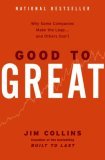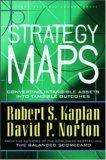Posts
Recommended Resource – Good to Great
/in Recommended Resources/by StrategyDrivenGood to Great: Why Some Companies Make the Leap… and Others Don’t
by Jim Collins
and
Good to Great and the Social Sectors: A Monograph to Accompany Good to Great
by Jim Collins
About the Reference
Written by Jim Collins, co-author of Built to Last, Good to Great: Why Some Companies Make the Leap… and Others Don’t identifies the common qualities of companies that have been able to make the lasting transition from average corporate performer to industry standout. In Good to Great and the Social Sectors: A Monograph to Accompany Good to Great
, Jim Collins shares his insights to the corollary behaviors of social sector organizations that have achieved superior performance.
Benefits of Using this Reference
StrategyDriven contributors like Good to Great not only for its revealing and sometimes surprising findings but because these findings are based on hard data and direct interviews from both the good to great and comparison companies. We found the insights presented in Good to Great and the Social Sectors
highly valuable in translating the for-profit company findings of the original text to the behaviors and programs supporting great government and not-for-profit company operations. Many of the best practice recommendations found on the StrategyDriven website exemplify behaviors and practices of companies seeking to move from good to great as described by these books.
Strategic Analysis Best Practice 1 – Integrity Without Excuses
/in Premium, Strategic Analysis/by Nathan Ives
Hi there! Gain access to this article with a FREE StrategyDriven Insights Library – Sample Subscription. It’s FREE Forever with No Credit Card Required.
| Sign-up now for your FREE StrategyDriven Insights Library – Sample Subscription
In addition to receiving access to Strategic Analysis Best Practice 1 – Integrity Without Excuses, you’ll help advance your career and business programs through anytime, anywhere access to:
Best of all, it’s FREE Forever with No Credit Card Required. |
Additional Information
Additional information regarding strategic analysis can be found in the StrategyDriven whitepaper series Strategic Planning.
About the Author

Strategic Planning Best Practice 3 – Strategic Discipline
/in Strategic Planning/by Nathan IvesExecutives seeking to focus their organization on mission achievement act with strategic discipline. By committing a significant portion their time and attention to the long-term direction of the organization, executives are more likely to recognize and properly respond to marketplace changes in a way that fully harnesses and focuses their organization’s energy on mission achievement.
Strategic discipline is demonstrated by managerial behavior that consistently and deliberately supports performance of a combination of planning, execution, and monitoring and control programs. Executives exhibit strategic discipline by maintaining awareness of marketplace trends, preparing for planning activities, reinforcing program execution, and making decisions and directing actions that drive the organization to appropriately respond to market factors. Through these behaviors, executives focus the organization’s attention and activities on mission achievement.
About the Author

Recommended Resource – Strategy Maps: Converting Intangible Assets into Tangible Outcomes
/in Organizational Performance Measures, Recommended Resources/by StrategyDrivenStrategy Maps: Converting Intangible Assets into Tangible Outcomes
by Robert S. Kaplan and David P. Norton
About the Reference
Strategy Maps: Converting Intangible Assets into Tangible Outcomes by Robert S. Kaplan and David P. Norton reveals how an organization can link performance measures covering the areas of operations, customer relationships, innovation, and regulatory and social processes to its mission and then leverage these ‘strategy maps’ to drive performance improvements.
Benefits of Using this Reference
StrategyDriven contributors like this reference because it illustrates how an integrated performance measurement system can be leveraged to drive organizational performance toward desired outcomes. This book is thorough in its discussions and provides the visual aids needed to make the concepts real to the reader.



